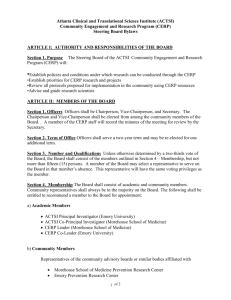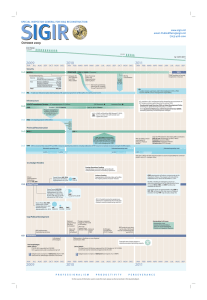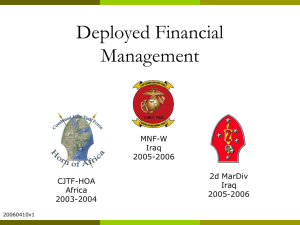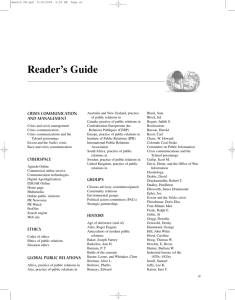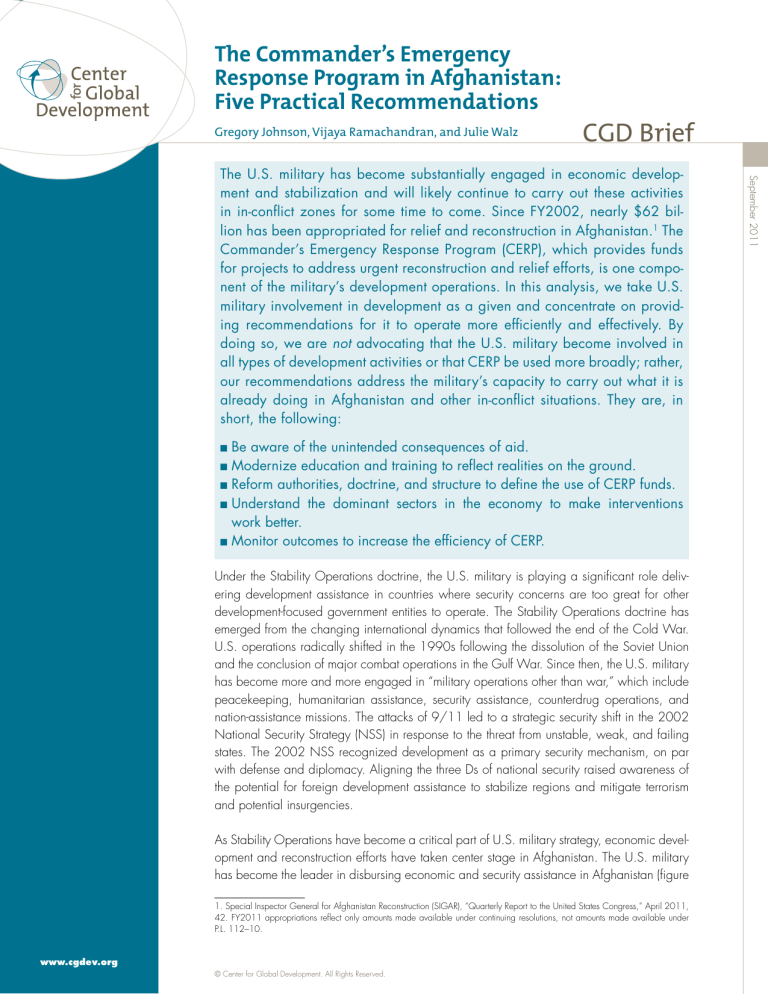
The Commander’s Emergency
Response Program in Afghanistan:
Five Practical Recommendations
Gregory Johnson, Vijaya Ramachandran, and Julie Walz
CGD Brief
Be aware of the unintended consequences of aid.
Modernize education and training to reflect realities on the ground.
n Reform authorities, doctrine, and structure to define the use of CERP funds.
n Understand the dominant sectors in the economy to make interventions
work better.
n Monitor outcomes to increase the efficiency of CERP.
n
n
Under the Stability Operations doctrine, the U.S. military is playing a significant role delivering development assistance in countries where security concerns are too great for other
development-focused government entities to operate. The Stability Operations doctrine has
emerged from the changing international dynamics that followed the end of the Cold War.
U.S. operations radically shifted in the 1990s following the dissolution of the Soviet Union
and the conclusion of major combat operations in the Gulf War. Since then, the U.S. military
has become more and more engaged in “military operations other than war,” which include
peacekeeping, humanitarian assistance, security assistance, counterdrug operations, and
nation-assistance missions. The attacks of 9/11 led to a strategic security shift in the 2002
National Security Strategy (NSS) in response to the threat from unstable, weak, and failing
states. The 2002 NSS recognized development as a primary security mechanism, on par
with defense and diplomacy. Aligning the three Ds of national security raised awareness of
the potential for foreign development assistance to stabilize regions and mitigate terrorism
and potential insurgencies.
As Stability Operations have become a critical part of U.S. military strategy, economic development and reconstruction efforts have taken center stage in Afghanistan. The U.S. military
has become the leader in disbursing economic and security assistance in Afghanistan (figure
1. Special Inspector General for Afghanistan Reconstruction (SIGAR), “Quarterly Report to the United States Congress,” April 2011,
42. FY2011 appropriations reflect only amounts made available under continuing resolutions, not amounts made available under
P.L. 112–10.
www.cgdev.org
© Center for Global Development. All Rights Reserved.
September 2011
The U.S. military has become substantially engaged in economic development and stabilization and will likely continue to carry out these activities
in in-conflict zones for some time to come. Since FY2002, nearly $62 billion has been appropriated for relief and reconstruction in Afghanistan.1 The
Commander’s Emergency Response Program (CERP), which provides funds
for projects to address urgent reconstruction and relief efforts, is one component of the military’s development operations. In this analysis, we take U.S.
military involvement in development as a given and concentrate on providing recommendations for it to operate more efficiently and effectively. By
doing so, we are not advocating that the U.S. military become involved in
all types of development activities or that CERP be used more broadly; rather,
our recommendations address the military’s capacity to carry out what it is
already doing in Afghanistan and other in-conflict situations. They are, in
short, the following:
Figure 1: Foreign Assistance in Afghanistan by
Agency, 2004–2009 (millions)
9,000
7,000
millions USD
Figure 3: Estimated Costs of CERP Projects
and Troop Levels
North: 11,000 NATO
DOD
USAID
Dept. of State
Dept. of Agriculture
8,000
West: 6,500 NATO
6,000
Kabul: 9,000 NATO
5,000
East: 36,500 NATO;
10,000 U.S. Enduring Freedom
4,000
3,000
Estimated costs of CERP
Projects
≤ $1,000,000
1,000
$1,000,001 – $5,000,000
0
2004
$5,000,001 – $20,000,000
2005
2006
2007
2008
2009
Source: USAID Greenbook data.
Note: DOD includes CERP, ASFF, and others.
1). The funds are being used to isolate and reduce insurgency, provide employment to local Afghans, and support
the campaign to “win hearts and minds.” One component
of the assistance package is CERP, a congressionally appropriated fund for commanders to use for development and
stabilization projects. It provides U.S. military commanders
with “walking-around money” for projects to address urgent
reconstruction and relief efforts. To date, Congress has appropriated $2.64 billion for CERP in Afghanistan (figure 2).
CERP is by definition a development program, often operating in the same areas as traditional development actors such as USAID. A breakdown by sector shows CERP
Figure 2: CERP Appropriations by Fiscal Year
to Afghanistan
1,000
800
600
Southwest: 32,000 NATO
$20,000,001 – $80,000,000
> $80,000,000
Source: Data on estimated costs of CERP project are from Public Intelligence, “Afghanistan Commander’s Emergency Response Program
Spending Data, 2010–2011,” posted December 2010, accessed August 4, 2011, http://publicintelligence.net/afghanistan-commandersemergency-response-program-cerp-spending-data-2010-2011/; data on
troop levels are from BBC News, “Afghan Troop Map: U.S. and NATO
deployments,” posted November 19, 2010, accessed August 28,
2011, http://www.bbc.co.uk/news/world-south-asia-11795066.
disbursements primarily in transportation, education, and
reconstruction—all sectors traditionally under USAID’s mandate. Yet USAID cannot operate well in some of the most
dangerous, but strategically important, areas of Afghanistan. A map of CERP spending in 2010 illustrates that the
areas that were to receive the largest amounts of money
were also the most insecure and violent areas with the highest concentration of troops (see figure 3).
Five Practical Recommendations
400
Recommendation 1: Be Aware of the
200
0
South: 35,000 NATO
Given current doctrine and ongoing involvement in Afghanistan, the U.S. military will likely be responsible for projects
beyond the traditional security realm for some time to come.
And as new players in development, the U.S. military has
substantial room to make its involvement more effective and
efficient.
1,200
millions USD
The Commander’s Emergency Response Program in Afghanistan: Five Practical Recommendations
2
Unintended Consequences of Aid
2004
2005
2006
2007
2008
2009
Source: SIGAR quarterly report to Congress, April 2011.
2010
There are no easy answers in creating stability or economic development in in-conflict zones, and no standardized approach will work across regions. Practitioners must
n
Create Training Support Packages (TSPs). The U.S. military should partner with other agencies, U.S. universities,
and the private sector to development a series of TSPs
that can be utilized by units preparing to deploy. TSPs
should also cover the fundamentals of project management, monitoring and evaluation techniques, outcomes
versus inputs and outputs, the differences between stability and development outcomes, and economics and business principles as they relate to military operations.
Recommendation 3: Reform Authorities, Doctrine,
Recommendation 2: Modernize Education and
and Structure to Define the Use of CERP Funds
Training to Reflect Realities on the Ground
To successfully revise training and education programs, the
U.S. military must also change doctrine and obtain permanent authorities that clarify and support the continued use of
CERP in military operations.
The U.S. military should augment its educational and training programs so that officers can cope with the complexities and challenges of stability operations and in-conflict
development.
n
n
n
n
n
Require economics, business, and development courses.
The military should require the study of economics, business, and development principles in its funded undergraduate civilian degree programs. Currently, economics,
business, and development courses are not mandatory
for the majority of military officers, and many may graduate from universities without any significant knowledge of
these topics.
Revise U.S. military education courses. More focus
should be placed on preparing officers to operate in
complex environments where understanding local social,
economic, and political issues is paramount to mission
success. Military education courses should expose officers
to basic concepts in anthropology, conflict mitigation, negotiation, needs assessments, and project management.
All are critical skills needed to navigate today’s complex
operating environment and to efficiently implement CERP
authority.
Broaden assignment opportunities and experiences. Programs that place officers in nonmilitary environments and
other U.S. government agencies should be expanded to
increase the number of officers involved and broaden the
number of organizations that participate.
Enhance training scenarios at military training centers.
Combined Training Centers and formal military exercises
should develop complex scenarios that test the U.S. military’s competence in economic assessments and implementation of CERP projects.
n
n
Revise CERP authority and guidelines. CERP authorities
need to be changed to allow the U.S. military a broad
range of options to stimulate private business; supporting small firms is a crucial step to generate economic
opportunities.
Revise Stability Operations and Counterinsurgency field
manuals. U.S. military doctrine should include more discussion of economic development principles and the drivers of economic growth. It should also explain how to
foster business creation, perform sector assessments, and
carry out effective project management.
Institutionalize Agribusiness Development Teams (ADTs).
The U.S. military should formalize the ADT structure in the
U.S. Army National Guard and institute similar unit structures in reserve and active U.S. Army Civil Affairs units.
Recommendation 4: Understand the Dominant
Sectors in the Economy to Make Interventions
Work Better
The U.S. military should focus more on learning about and
developing the tools necessary to understand the agriculture,
manufacturing, processing and production, and construction
sectors of the economy. The agriculture sector in Afghanistan constitutes 33 percent of the value-added GDP and employs approximately 80 percent of the Afghan workforce,
yet CERP expenditures in agriculture from 2004 to 2009
constituted only 5 percent of the total executed during that
period. Focusing on the dominant sectors will improve the
effectiveness of CERP funding.
3
September 2011
understand local conditions and capacities at the most micro
level and pay greater attention to unintended consequences.
The U.S. military must understand that large flows of aid
will affect social stability, power relationships, and social
and cultural norms. Immediate relief efforts may undermine
long-term development goals, and there are trade-offs and
dynamics between goals of humanitarian assistance, stabilization, and economic development. Our first overall recommendation is to understand the potential for unintended
consequences and undertake efforts to do no harm.
Global Development works to reduce global
poverty and inequality through rigorous research and active
engagement with the policy community to make the world a more
The
Center
for
prosperous, just, and safe place for us all. The policies and practices of
the United States and other rich countries, the emerging powers, and
international institutions and corporations have
significant impacts
on the developing world’s poor people. We aim to improve these policies
and practices through research and policy engagement to expand
opportunities, reduce inequalities, and
n
n
improve lives
Conduct in-depth sector assessments. Understanding the key components of sector activity will enable
CERP funds to be used more efficiently.
Create an accessible knowledge bank of key economic information. Key economic information should
be based on assessments done by U.S. military units,
U.S. government agencies, and other partners or
organizations.
Recommendation 5: Monitor Outcomes to
Increase the Efficiency of CERP
Monitoring and evaluation are crucial if the U.S. military is to continue to be substantially engaged in efforts
beyond providing stability. There should be three types
of results measurement for the following:
n
n
Short-run inputs such as the purchase of good and
services and better tracking of where CERP money
is actually spent. This information also needs to be
transferred internally as commanders rotate.
Intermediate outcomes such as increased local
government funds for social programs, successful construction of infrastructure projects, and local
ownership.
n
everywhere.
Long-term results such as real unemployment, school
enrollment and literacy rates, and growth of agricultural exports. The third set of outcomes may be
beyond the time horizon and capabilities of the
U.S. military; in such cases, collaboration with other
agencies and NGOs is vital as they can continue
to track results long after the military has concluded
official engagement.
Next Steps
Much can be learned from analyzing the U.S. military’s
use of CERP in Afghanistan. The Pentagon should undertake a broad survey of U.S. military members involved in executing CERP to determine the following:
(1) commanders’ intent for CERP funds and how projects
were prioritized; (2) what assessment mechanisms were
used to determine projects; (3) how monitoring and
evaluation is taking place; and (4) what outcomes were
identified for each project, and how monitoring and
evaluation was linked to ensure desired effects.

